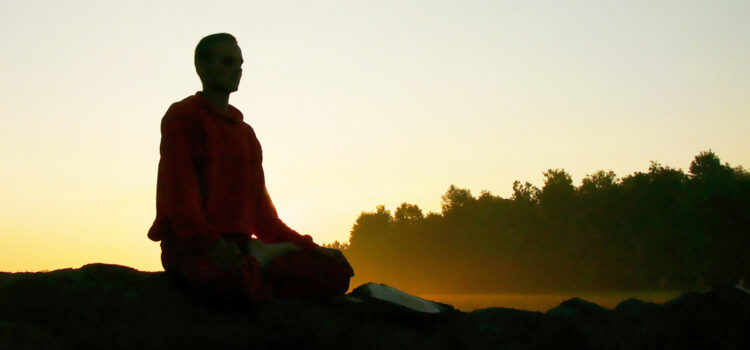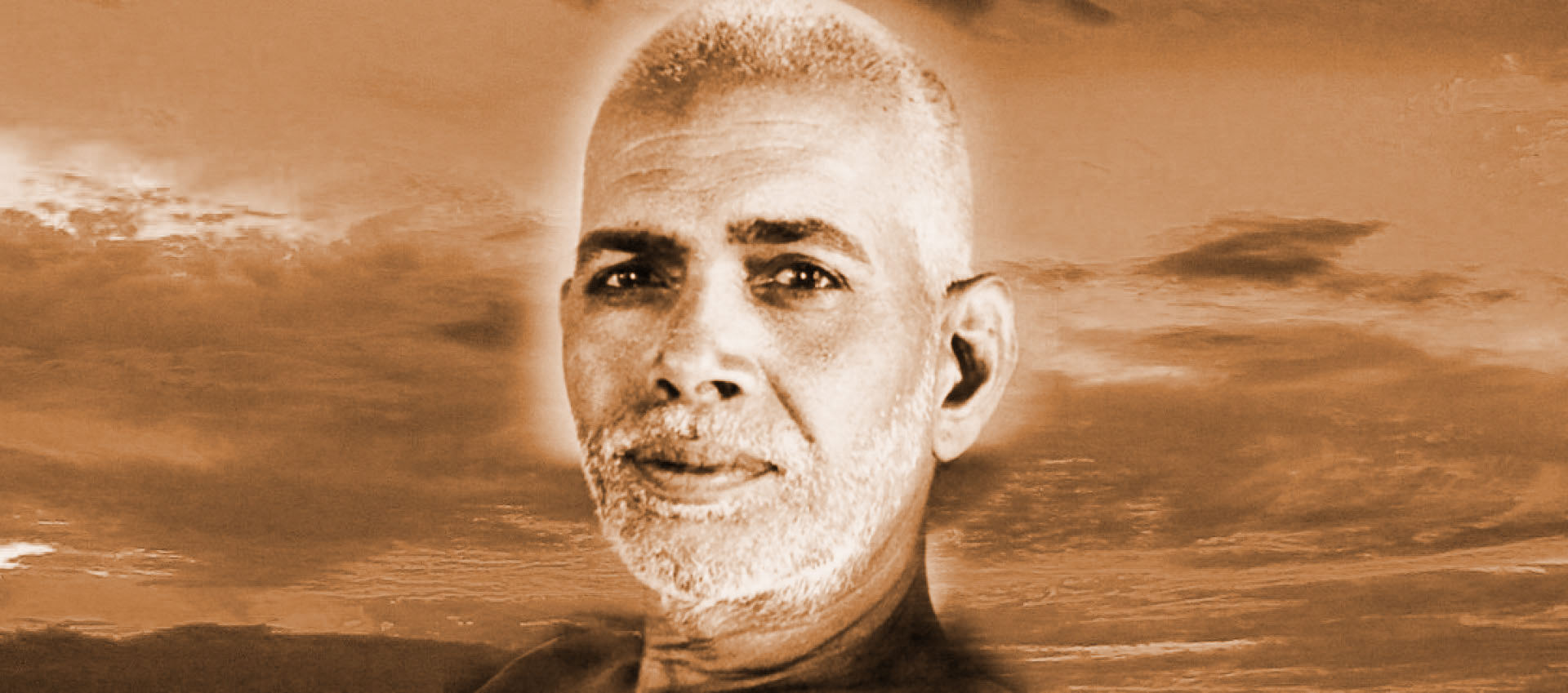
What is Meditation? How to do it? (3)
~~~~~~~~
Talk 371.
D.: What is dhyana (Meditation) ?
M.: Dhyana is holding on to a single thought and putting off all other thoughts.
D.: What is to be meditated upon?
M.: Anything that you prefer.
D.: Siva, Vishnu, and Gayatri are said to be equally effective. Which should I meditate upon?
M.: Any one you like best. They are all equal in their effect. But you should stick to one.
D.: How to meditate?
M.: Concentrate on that one whom you like best. If a single thought prevails, all other thoughts are put off and finally eradicated. So long as diversity prevails there are bad thoughts. When the object of love prevails only good thoughts hold the field. Therefore hold on to one thought only. Dhyana is the chief practice.
Dhyana means fight. As soon as you begin meditation other thoughts will crowd together, gather force and try to sink the single thought to which you try to hold. The good thought must gradually gain strength by repeated practice. After it has grown strong the other thoughts will be put to flight.
This is the battle royal always taking place in meditation.
One wants to rid oneself of misery. It requires peace of mind, which means absence of perturbation owing to all kinds of thoughts. Peace of mind is brought about by dhyana alone.
D.: What is the need then for pranayama (breath control)?
M.: Pranayama is meant for one who cannot directly control the thoughts. It serves as a brake to a car. But one should not stop with it, but must proceed to pratyahara (withdrawal from external influences), dharana (concentration or single focus) and dhyana (meditation). After the fruition of dhyana, the mind will come under control even in the absence of pranayama.
The asanas (postures) help pranayama, which helps dhyana in its turn, and peace of mind results. Here is the purpose of hatha yoga.
Later Sri Bhagavan continued:
When dhyana is well established it cannot be given up. It will go on automatically even when you are engaged in work, play or enjoyment. It will persist in sleep too. Dhyana must become so deep-rooted that it will be natural to one.
D.: What rite, ritual or action is necessary for the development of dhyana?
M.: Dhyana is itself the action, the rite or ritual and the effort. It is the most intense and potent of all. No other effort is necessary.
D.: Is not japa necessary?
M.: Is dhyana not vaak (speech)? Why is japa necessary for it? If dhyana is gained there is no need for anything else.
D.: Is not a vow of silence helpful?
M.: A vow is only a vow. It may help dhyana to some extent. But what is the good of keeping the mouth closed and letting the mind run riot. If the mind be engaged in dhyana, where is the need for speech? Nothing is as good as dhyana. If one takes to action with a vow of silence, where is the good of the vow?
D.: What is jnana-marga?
M.: I have been saying it for so long. What is jnana? Jnana means realization of the Truth. It is done by dhyana. Dhyana helps you to hold on to Truth to the exclusion of all thoughts.
D.: Why are there so many Gods mentioned?
M.: The body is only one. Still, how many functions are performed by it? The source of all the functions is only one. It is in the same way with the Gods also.
D.: Why does a man suffer misery?
M.: Misery is due to multifarious thoughts. If the thoughts are unified and centred on a single item there is no misery, but happiness is the result. Then, even the thought, “I do something” is absent; nor will there be an eye on the fruit of action.
~~~~~~~~
Talk 328
M.: What is mind? Find it. If you search for it, it will vanish by itself. For it has no real existence. It is comprised of thoughts. It disappears with the cessation of thoughts.
D.: Do I remain then?
M.: What is your experience in sleep? There were no thoughts, no mind, and yet you remained then.
D.: When I try to meditate, I am unable to do so because my mind wanders. What should I do?
M.: Your question furnishes the answer. First, with regard to the first part of the question, you say you concentrate, but do not succeed. ‘You’ means ‘the Self’. On what do you concentrate? Where do you fail? Are there two selves, for the one self to concentrate on the other? Which is the self now complaining of failure? There cannot be two selves. There is only one Self. That need not concentrate.
You ask, “But then, why is there no happiness?” What is it that prevents you from remaining as the spirit which you are in sleep? You yourself admit that it is the wandering mind. Find out the mind. If its ‘wandering’ stops, it will be found to be the Self – your ‘I’-consciousness which is spirit eternal. It is beyond knowledge and ignorance.
If the mind is watched thoughts cease. Peace results and it is your true nature.
Dhyana, contemplation and mental japa are the same. When thoughts cease to be promiscuous and one thought persists to the exclusion of all others it is said to be contemplation or meditation. The object of japa or dhyana is the exclusion of several thoughts and confining oneself to one single thought. Then that thought too vanishes into its source – absolute consciousness, i.e., the Self. The mind engages in japa and then sinks into its own source.
Because you are with other thoughts, you call the continuity of a single thought, meditation or dhyana. If that dhyana becomes effortless it will be found to be your real nature.
~~~~~~~~
Talk 326.
In answer to a question by a long time resident attendant Sri Bhagavan said: “Everybody complains of the restlessness of the mind. Let the mind be found and then they will know. True, when a man sits down to meditate thoughts rush up by dozens. The mind is only a bundle of thoughts. The attempt to push through the barrage of thoughts is unsuccessful.
If one can by any means abide in the Self it is good. For those who are unable to do so, chanting or meditation (Japa or dhyana) is prescribed. It is like giving a piece of chain to an elephant to hold in its trunk. The trunk of the elephant is usually restless. It puts it out in all directions when taken out in the streets of the town. If given a chain to carry the restlessness is checked. Similarly with the restless mind. If made to engage in japa or dhyana, other thoughts are warded off: and the mind concentrates on a single thought. It thus becomes peaceful. It does not mean that peace is gained without a prolonged struggle. The other thoughts must be fought out.
~~~~~~~~
Talk 338.
Mrs. Jennings, an American lady, asked a few questions:
D.: Is it not better to say ‘I am the Supreme Being’ than ask ‘Who am I?’
M.: Who affirms? There must be one to do it. Find that one.
D.: Is not meditation better than investigation?
M.: Meditation implies mental imagery, whereas investigation is for the Reality. The former is objective, whereas the latter is subjective.
D.: There must be a scientific approach to this subject.
M.: To reject unreality and seek the Reality is scientific.
D.: I mean there must be a gradual elimination, first of the mind, then of the intellect, then of the ego.
M.: The Self alone is Real. All others are unreal. The mind and intellect do not remain apart from you.
The Bible says, “Be still and know that I am God”. Stillness is the sole requisite for the realization of the Self as God.
D.: Will the West ever understand this teaching?
M.: There is no question of time and space. Understanding depends on ripeness of mind. What does it matter if one lives in the East or in the West?
~~~~~~~~
Talk 287.
A gentleman, doctor by profession, came here with his wife to visit Sri Bhagavan. He was in the hall when Sri Bhagavan came in after lunch; then he asked: “How should I meditate? I do not have peace of mind.”
M.: Peace is our real nature. It need not be attained. Our thoughts must be obliterated.
D.: I have been trying to obliterate them but I am not successful.
M.: The Gita method is the only one for it. Whenever mind strays away bring it back to bear on meditation.
D.: I cannot bring my mind to meditate.
Another devotee: An elephant when free puts its trunk here and there and feels restless. If a length of chain is given to it, the trunk holds it and is no longer restless. Similarly, mind without an aim is restless, with an aim it remains at peace.
D.: No, no, it is all theory. I have read many books. But no use. It is practically impossible to make the mind concentrate.
M.: Concentration is impossible so long as there are predispositions. They obstruct bhakti also.
The interpreter advised the questioner to study Who am I? The doctor was ready with his protestations: “I have read it also. I cannot still make my mind concentrate.”
M.: By practice and dispassion — abhyasa vairagyabhyam.
D.: Vairagya is necessary …
M.: Abhyasa and vairagya are necessary. Abhyasa is concentration on one thought only; Vairagya is the absence of diffused thoughts. The one is the positive and the other the negative aspect of meditation.
D.: I am not able to do so by myself. I am in search of a force to help me.
M.: Yes, what is called Grace. Individually we are incapable because the mind is weak. Grace is necessary. Sadhu seva is meant only for it. There is however nothing new to get. Just as a weak man comes under the control of a stronger one, the weak mind of a man comes under control easily in the presence of the strong-minded sadhus. That which is – is only Grace; there is nothing else.
The questioner said, “I request your blessings”.
Bhagavan said: “Yes – yes.”

